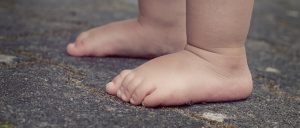The human foot is one of the most complex skeletal-muscular systems in the body. And it works perfectly for what it was designed for. Babie’s feet contains no bones at all and consists of a mass of cartilage, which, over a period of years, ossifies to become the 26 bones that exist in the adult human foot. This process is not complete until the late teens, so it is crucial that footwear – when worn – is well chosen. The bones in the foot are very soft at this age. Wearing badly fitted shoes won’t deform your toddler’s feet, but if his shoes aren’t very supportive, it can advance any abnormalities that his feet may already have, such as flat feet.
Children’s feet differ from those of adults
At birth and throughout the first year or so of life, babie’s feet are quite different in many ways from those of an adult. Firstly they are a different shape, being wider in the forefoot and narrow at the heel with the toes often being curly. Secondly the bones are undeveloped and at this stage consist of nothing more than cartillage, so they are soft and pliable. This is why small children can appear to do things to their feet without any harm at all, which would certainly injure an adult.
Should you let your kids be barefoot?
It depends!. When your child first begins to walk, shoes are not necessary indoors. Allowing babies to go barefoot or to wear just socks helps the foot to grow normally, promotes the grasping action of toes and thus strengthen the muscles in the feet. Children learning to walk should be allowed to do without footwear and on varied surfaces as much as possible. Once your baby is ready to walk outside, when it is cold or the surface is rough, the protection of shoes becomes necessary. Buy a good quality shoe. A flexible, soft soled shoe is appropriate with the uppers at least, being of leather.
Tips & Advice for children’s foot care
- When the protection of shoes becomes necessary, let it be comfortable. Footwear that is too tight can restrict growth and development of the feet
- Keep children’s shoes in good repair.
- Replace shoes with a larger size as soon as necessary.
The right shoes for small children
- The upper part of the child’s shoe should be made of breathable materials like leather, canvas or the newer mesh materials.
- It’s very important that the shoe be shaped like the child’s foot.
- Shoes should have a toe-box that’s wide and round or square, to naturally follow the shape of the foot, with adequate room so the toes aren’t squished together.
- The sole needs to be flexible too so that it will bend with the foot.
- Shoes should fit comfortably around the heel and not be too loose or too tight
- Children’s shoes should have some fastening system. As a general rule, avoid backless or slip-on
Sources: walkingclinic.com.au, iocp.org.uk, ipfh.org, aofas.org



